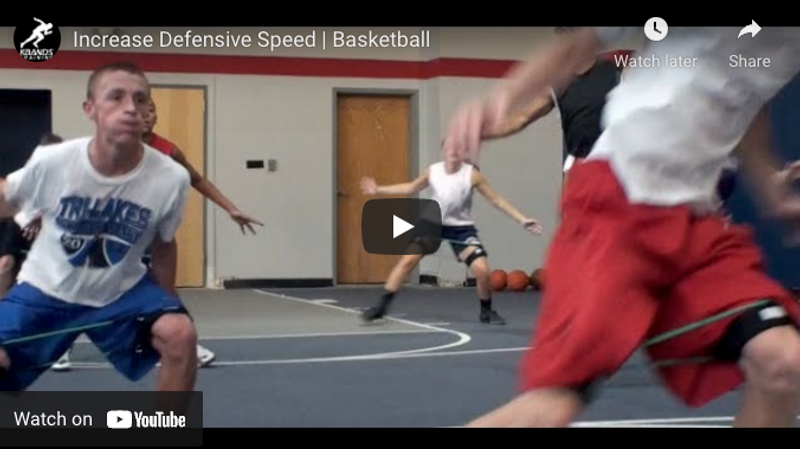Play Defense like the Pros
A strong, agile defensive game is crucial to a winning basketball games, and great defense begins and ends with a body position that’s low and mobile. Rapid direction changes, explosive energy, and powerful velocity control are all supported by a low and centered core. So what can basketball players do to add stability and increase speed during their defensive maneuvers?
There are several moves that help speed up a defensive game while bringing it under tight control. Some of these moves and drills are covered in other parts of the basketball performance pack, but these drills mean little without plenty of time and attention focused on the defensive shuffle. In the basketball clinic featured in the video below, Trevor Theismann of Kbands Training.com leads a group of young basketball players through a series of moves designed to bring body control toward the center and increase speed during defensive maneuvering. Watch as the clinic progresses and note how the basketball players use the moves to build power and explosiveness on the court.
Increase Speed: Position Changes to the Left and Right
A powerful professional defense relies on the body’s ability to change direction quickly in response to cues, but also to stay aligned and centered while doing so. The chest should stay above and between the hips at all times, which can be challenging to basketball players as they execute rapid changes in speed and direction.
During the first exercise in the basketball clinic, basketball players drop their center of gravity down below the line of the hips while planting their feet wide and extending their arms to the sides for balance. While holding this low and controlled stance, they move to the left or right in response to Trevor’s unexpected points. To increase speed and maintain stability, they work to keep their feet apart as they move. The closer the feet come together, the higher the center of gravity rises, and the more likely the basketball players are to lose their balance and agility when they’re asked to increase speed and change direction without warning.
Note how the basketball players who struggle to stay low also struggle to respond to quick changes, and vice versa. As the center of gravity rises and the chest becomes displaced from the centerline, the body has a difficult time controlling its momentum and recovering from rapid turns.
Increase Speed: Position Changes Forward and Backward
During the second exercise in the basketball workshop, the basketball players respond not only to left-right direction changes, but also forward-backward cues as well. They still need to maintain and increase speed and keep their attention focused forward, but they must learn to control their chest-hip alignment and bodily momentum on a new set of coordinates. During the game, effective defense requires agile changes in 360 degrees, and these drills can help players build necessary balance and focus.
As the point moves to the back of the room, the basketball players drop their right shoulders back, rotate their bodies, and continue the shuffle. When the point moves to the front of the room, their left shoulders come forward and they increase speed in a new direction. At all times, their attention remains forward, their feet stay wide, and their chests and centers stay low and controlled.
Basketball Defensive Drills and the Kbands
These basketball defensive drills are challenging even without added resistance, but the addition of the Kbands brings a new level to the exercise as it elevates both the difficulty and the speed of results. In the video, the basketball players have the Kbands strapped securely around their upper legs, generating tension every time the legs widen to the sides or scissor forward and back.
In this specific exercise, the added pressure created by the Kbands will be concentrated in the hip flexors and lower core. Every time the basketball players widen and lower their stance, the bands will exert an inward pull on the upper legs, drawing the body line inward and upright, and creating obstacles as players try to maintain a proper position. The additional strength and balance generated by this resistance will help the players on the court later when the bands are removed.

